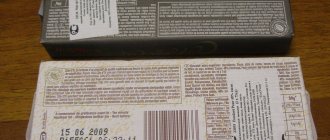What you should know
First of all, you need to understand what yeast is. Any type of this substrate consists of living organisms (unicellular fungi). The mushrooms cause fermentation, which causes the dough to rise and become fluffy.
- For the alcoholic fermentation process to proceed normally, fungal organisms must remain active and viable. And you can create suitable conditions for them by observing the humidity level and temperature conditions.
- There is no substance in yeast that could prevent the evaporation of moisture. Therefore, they are stored at a humidity of 98%. In a drier place, the product loses up to 10% of its weight.
- All types of yeast are living microorganisms, so they need to “breathe”. For this reason, yeast should not be placed in vacuum bags before storing in the refrigerator.
- Each variety of this substrate has its own shelf life, which is usually indicated in the manufacturer’s recommendations on the packaging.
What types are there?
Yeast is different from all other dough ingredients in that it is alive. Doughs rise and rise thanks to their unique ability to convert the sugar found in flour into carbon dioxide and alcohol. In order for this ability of yeast to remain, it is necessary to properly preserve it at home.
Yeast can be purchased at a store or pharmacy in this form:
- pressed - blocks of different weight packaging, wrapped in special paper (fresh yeast has a delicate cream color);
- dry active - granular, packaged in a special bag (30 g dry is approximately equal to 100 g pressed);
- instant (fast-acting) - seemingly dry small sticks, added directly to the dough;
- beer (wine) - sold in vacuum packages in dry form, can be in the form of tablets, powder or flakes, can be purchased in specialized stores or pharmacies.
Pressed
Most often you can buy compressed baker's yeast. If they are fresh and of high quality, their color will be soft - creamy, uniform. And their aroma has a slight sour tint. When lightly pressed, the product should crumble. But a good product cannot be sticky. It is mainly sold in bars of different sizes.
The question of how to store compressed yeast comes to every housewife immediately after purchasing it, and for good reason. After all, a fresh product is quite sensitive to the environment.
Shelf life
Storage of compressed yeast without refrigeration can last no longer than 24 hours. But you can increase their storage time by another 3 - 4 days. To do this, sprinkle a little salt on the block or treat it with flour.
The shelf life of compressed yeast in the refrigerator will be about 2 weeks. It is important that the temperature is constant and ranges from 0°C to +4°C. It is better to choose parchment paper as a packaging material. A plastic bag is not suitable for this, since living organisms (mushrooms) must breathe.
You can also store yeast in the freezer. There is a belief that freezing temperatures are detrimental to yeast. But this belief is not true. Freezing slows down the life processes of mushrooms. As a result, they are in a state of “anabiosis”. When defrosted, the original properties are restored.
Before storing the yeast in the freezer, it is divided into parts of the required size and wrapped in wax paper (foil). In the freezer they can remain fresh for 6 - 12 months (depending on the initial condition of the product).
It is important to remember that yeast cannot be re-frozen.
This type of product can also be stored in dried form.
- To do this, the sticks are pre-crushed;
- then mix with flour;
- then dried at natural temperature. The resulting crumbs are placed in a small layer on a parchment-lined tray.
- The product is stirred frequently and care is taken to ensure that there is constant access to air.
After drying, the workpiece is placed in glass containers and covered with pieces of fabric (air should flow inside the jar unhindered), and then secured with rubber bands.
The shelf life of dry compressed yeast is about 6 months. They must be placed in a dark, dry and cool place.
Dry
How long dry yeast can be stored will be determined by its moisture content.
There are several types of dry substrate, and each of them has its own characteristics.
Dry (instant) yeast of instant action
They are produced in granules having a cylindrical shape. And there is no need to pre-activate this product (just stir it with flour). The humidity level of such products is low - 3 - 3.5%, which is why they can be stored longer.
Storing dry yeast does not require special conditions. It is enough that they are in a dark place with a low level of humidity.
The shelf life of dry yeast in sealed packaging is 2 years from the date of manufacture.
If the package is opened, its contents will retain their original properties for only 48 hours. But if you move the contents into a glass container, close it tightly and send it to a cold place, the shelf life will be already 2 weeks.
Dry active
This product is presented in powder form, and the moisture content is 6 - 9%. This product should be stored in dry, dark places.
The shelf life of factory-packaged dry active yeast is 6 - 18 months.
And after opening the package, the product retains its quality for about 1 month. Store in a sealed glass container on the refrigerator shelf.
Once the seal of the package is broken, its contents can be frozen, first dividing into small portions. In this case, the shelf life will increase to 6 months.
Dry yeast
This product is even more dehydrated, retaining only 8% moisture. It is recommended to use much less dry yeast for the same amount of flour than regular pressed yeast. It is worth noting that the packaging does not indicate at what temperature dry baker’s yeast dies. According to official data, such a product ceases to function at temperatures above 55 °C.
Dry yeast granules are very easy to store; they are already in vacuum packaging. The shelf life increases sharply to two years. At the same time, they need to be taken much less than conventional pressed ones. For 100 g of regular live yeast you only need 30 g of dry yeast.
It is worth noting separately that quite a large number of people confuse this product with rapid-acting yeast and mix it directly with flour, but this cannot be done. This product must be sprinkled on warm water (recommended temperature 30...45 degrees), then wait until bubbles appear on the surface of the liquid; this procedure usually takes 10 - 15 minutes. After this, you can knead the required dough. The main thing is to remember at what temperature the yeast dies.
Beer houses
In order for brewer's yeast to retain its quality for as long as possible, it must be filled with cooled boiled water, maintaining a 1:1 ratio. This type should be stored exclusively on the refrigerator shelf.
You need to drain the water once every 2 days. This will enable the yeast to obtain the necessary amount of oxygen for normal existence. After 2 days, the mushrooms are again filled with water.
The shelf life of brewer's yeast in the refrigerator is 1 month. After this time, the beer mushroom begins to lose its original quality. And in warm conditions it will lose effectiveness within a few hours.
The container in which brewer's yeast is stored must have a volume at least 2 times larger than its contents, since this product is capable of expanding.
- At + 4°C -+7°C, beer starter will retain its properties for up to 4 months.
- In dry form, these products will remain usable for up to 2 years.
- Frozen storage of brewer's yeast is not recommended: this culture does not retain vital activity at subzero temperatures.
Marking
Yeast is a perishable substance; the manufacturer is obliged to put on the packaging the date of manufacture, as well as the end date when this product will no longer be suitable for consumption.
Often, a substance retains its beneficial qualities longer than the date specified by the manufacturer, but the warranty is automatically canceled. The packaging must indicate the conditions under which it is recommended to store this product.
We suggest you read How to quickly break in tight or new shoes
Storage tips
The yeast substrate has the ability to absorb all the aromas of the environment. Based on this, it should not be kept near products that have a strong odor.
Yeast that is exposed to low temperatures does not always maintain quality. Therefore, their condition should be monitored. Anyone can check the germination of the product using the following method:
- Milk in the amount of 200 ml. should be heated to +30°C, and then add 1 tsp. flour or sugar.
- After this, the top layer (darker shade) is removed from the yeast briquette and dissolved in milk.
- If foam appears on its surface after 10 - 15 minutes, the yeast substrate is alive.
How yeast should be stored is a pressing question for those involved in baking and producing intoxicating drinks. And our article will help you figure this out.
Yeast is an essential component for making delicious baked goods and homemade drinks. It's no secret that this is a rather capricious product. In this article we will talk about how to properly store yeast at home.
How to store compressed yeast
Fresh compressed yeast is one of the most common types of baker's yeast. A high-quality product has a delicate cream color, a slightly sour smell, crumbles easily when pressed and does not stick to your hands. As a rule, such yeast is sold packaged in portioned bars. The first question that arises when purchasing: where to store yeast?
It is recommended to store compressed yeast at room temperature for no more than a day. To slightly increase this period, you can sprinkle the yeast with flour or salt - then the product will retain its properties for about 3-4 days.
You can extend the freshness of the yeast up to 2 weeks in the refrigerator. Pressed yeast is stored at temperatures from 0 to +4 ℃. You can use parchment or foil for packaging, since yeast needs air access.
Do not use polyethylene to store yeast - the yeast fungus “suffocates” without oxygen.
Can compressed yeast be stored in the freezer? There is an opinion that at low temperatures the yeast fungus dies, but this is not true. It suspends vital processes, falling into so-called suspended animation. After defrosting, all properties of the yeast remain the same.
Yeast should be stored by first dividing it into portions of the required size. The pieces are wrapped in foil or parchment and placed in the freezer. The product should be defrosted in the refrigerator. Yeast cannot be re-frozen. Shelf life is from 6 to 12 months depending on the quality of the original product.
Another method of storing yeast is drying. The yeast block is finely crushed and mixed with a small amount of flour. Then pour the crumbs onto a baking sheet lined with paper and dry at room temperature. The yeast needs to be provided with good air ventilation and stirred periodically. The dry preparation is transferred to jars, covered with a cloth and tied with an elastic band (the fungi must breathe). This yeast can be stored in a cool, dark place for several months.
Can it be frozen?
Is it possible to store dry and fresh yeast in the freezer - after all, these are microorganisms? In principle, you can freeze any yeast, with the exception of brewer's yeast. Just remember that at temperatures below -2 °C the crop may die. On the other hand, freezing can significantly extend its shelf life.
To preserve the raw compressed product for up to 12 months, it can be placed in the freezer. For this:
- Divide it into small, easy-to-defrost pieces.
- Wrap each briquette in cling film, parchment or foil and put it in the freezer.
- Thaw in batches as needed at room temperature until soft.
You can also do this with unused dry yeast. Namely, package them in small sealed packages and place them in the freezer.
Following simple “tricks” will help to preserve for a long time the biological component that is important for delicious baked goods. Of course, the best option is to purchase a “live” product as needed and in small quantities, because stale and expired yeast will not rise the dough, and baking will not work.
Store correctly and be healthy!
There are 3 types of baker's yeast: fresh pressed, dry granulated active and dough. Let's figure out how to properly store yeast.
Fresh compressed yeast As a rule, such yeast is sold in the form of briquettes weighing 50 g or 100 g. They have a uniform cream color and break (flake) into pieces when pressed. This type provides the strongest fermentation and suitable dough consistency. Fresh yeast should not be stored in sealed containers, since, like any living organism, it must “breathe” to maintain its viability. At room temperature, fresh yeast can be stored for no more than a day. But in the cold, the fermentation process slows down somewhat, and they remain suitable for another 10-12 days at a temperature of 0 to 4 degrees. If you do not have the opportunity to store yeast in the refrigerator, experienced housewives advise sprinkling it with salt or flour, then its shelf life will be extended by 3-4 days. However, storing compressed yeast in this form is only possible if the room temperature does not exceed 39-42 degrees. If your yeast is nearing the end of its shelf life and you are concerned about its effectiveness, try to “revive” it before using it by grinding it in a small amount of warm water with the addition of 1-2 tsp. Sahara. If the resulting dough bubbles after 10-15 minutes, then the yeast has “come to life” and is suitable for use.
Dry yeast Storage of dry yeast depends on its subtype. There are dry granular and dry active. When granulated yeast is obtained, it is freed from more than 60% moisture, but the remaining moisture does not allow it to be suitable for too long. Such yeast is stored in the refrigerator at temperatures below 10 degrees for about 5-6 weeks. Storing active yeast is much longer and easier. This is due to their significant dehydration. These are packaged in hermetically sealed packaging, and their storage conditions are absolutely non-specific. Even at room temperature they can retain their qualities for up to 2 years.
Dough By dough we mean a natural leaven, traditionally made from flour and water. This dough is specially left for several days to sour enough. The ripening of the dough lasts about 4 days (according to other sources, less). Part of this dough is usually used for baking, and a new one is made on the basis of the other. Where to store the dough? - you ask. It is convenient to store such dough in the refrigerator or other cold place. Such a dough should also not be hermetically sealed, because it is through the air that yeast spores enter the mixture. Bread made from sourdough is considered the best and most healthy, and it has a special taste.
Many people love homemade baked goods. But it succeeds only when the housewife uses fresh yeast to prepare the dough, which is responsible for the tenderness and airiness of the baked goods. Therefore, their storage conditions are very important. For example, you need to know how long and how to store yeast in the refrigerator, whether this can be done at all, or is it better to choose another method.
You will learn about all this by reading this article.
How to store other types of yeast
Not only baker's yeast is used on the farm: live, brewer's, wine and alcohol yeast are used for medicinal purposes and for the preparation of various drinks. Each variety requires compliance with certain storage conditions. Let's take a closer look at them.
Liquid yeast. This type of yeast must be stored in the refrigerator. The jar of yeast is covered with cloth or gauze and stored for up to 1 month without feeding. To increase shelf life and as a complementary food, dissolve 1-2 teaspoons of sugar or honey in yeast. Using this method, liquid yeast can be stored for quite a long time.
Brewer's yeast. Brewer's yeast is stored in the refrigerator in a glass container, diluted with cold, unboiled water in a 1:1 ratio. The water must be drained periodically (every 1-2 days), allowing the fungus to “catch its breath,” and then fill it with water again. It is best to use yeast within a month as it loses its effectiveness over time. At room temperature, brewer's yeast spoils in a matter of hours.
Dry brewer's yeast is also available for sale. This type of product is stored in the refrigerator for about 2 years.
Brewer's yeast, unlike other varieties, is not recommended to be frozen - low temperatures are detrimental to it.
Wine yeast. This product has a moisture content of 6%. Yeast can be stored for up to 2 years in a dry, dark place at a temperature not exceeding +15 ℃.
Alcoholic yeast. The most common is dry alcoholic yeast. This type of product has a moisture content of 7% and is sold in vacuum packaging. In a dry, dark place at a temperature no higher than +15 ℃, alcoholic yeast can be stored for up to 2 years (although some manufacturers indicate a shelf life of up to 5 years).
We hope that our tips will be useful to you. What methods of storing yeast do you follow? Share your experiences and secrets in the comments.
Proper storage of yeast is the key to the quality of the finished product. Yeast mixtures contain microscopic fungi that cause fermentation, so it is important to create optimal conditions to preserve beneficial properties.
What is yeast and how to store it?
Thanks to fungi, which housewives know as yeast, the dough is enriched with carbon dioxide and rises. The baked goods turn out fluffy and soft. Yeast is a living organism, which means it shouldn’t be stored in any way. They need either access to oxygen or isolation in the freezer. The fact that these are food fungi should also be taken into account when preparing dishes: the organisms are afraid of high temperatures and direct sunlight.
There are several varieties of yeast:
- Fresh or pressed are sold in briquettes. They are stored either at room temperature or in the refrigerator or freezer. Raw yeast dies quickly and needs high humidity. They will last no more than 2, maximum 4 days in the kitchen cabinet.
- Dry varieties need a dry and well-ventilated area. These bags stay in the kitchen cupboard for a long time. Granulated yeast must be used 1.5 months in advance; active yeast can wait up to six months. There is also a fast-acting variety that can be stored for up to 2 years, but when the package is opened, the shelf life is reduced to 2 days. By the way, in addition to fungi, such packs contain various enzymes and minerals.
- But alcoholic yeast can only be stored in the refrigerator; there is no place for it in the freezer.
- Brewer's yeast is diluted with water in a jar and stored for a month in the refrigerator. You cannot freeze them dry - they lose their properties.
When placed in the freezer, the yeast does not die, it only goes into suspended animation. Upon returning to warmth, they become active again.
How to store yeast at home
Fresh yeast is used to make confectionery and bakery products, and some types of drinks. With them, the dough is light, the bread is shape-resistant, and the baked goods are fluffy and soft. In an unfavorable environment, yeast compounds quickly lose their beneficial properties and enzymatic activity. The choice of location and storage conditions depends on the type and composition of the product.
There are several types of yeast products used for baking:
- liquid - used in baking;
- pressed - before use they are dissolved in a warm liquid (water or milk);
- active - in the form of dry round granules, the activation of which requires warm liquid and some time to soften;
- instant (instant) - dry cylindrical granules that are added to flour during kneading without prior activation;
- rapid baking mixtures are a type of dry yeast in the form of small granules that dissolve faster in the dough, increasing its lifting force.
In the production of strong alcoholic drinks, alcoholic yeast mixtures are used.
Yeast should be stored at home in a well-ventilated dry cellar, refrigerator or freezer, because at room conditions, oxygen and air humidity affect the activity of fermentation enzymes, and the product loses its potency. It is necessary to move the yeast mixtures to different temperature regimes gradually.
How to store open dry yeast and compressed
Open packs of instant (instant) types must be consumed within 2 days, dry active ones - within 1 month. Granular formulations can be stored for up to 3 months in the original packaging; after opening, the contents of the bag must be used for their intended purpose on the same day.
The shelf life of dry yeast in a closed package is 12-18 months. After opening the package, the remaining yeast mixture is poured into a glass container with a tight-fitting lid or a plastic box, which is placed on the refrigerator door.
Pressed yeast has a solid consistency and crumbles well. The product is obtained as a result of fermentation of mushrooms, so it quickly deteriorates. Yeast can be stored for a short amount of time: in a warm room for 24 hours, on a refrigerator shelf at 0...+4°C - about 2 weeks unpacked and up to 30 days in a closed package, at a temperature of +3...+6° C - no more than 12 days.
To extend the shelf life by 3-4 days and maintain lifting power, the yeast bars are sprinkled with salt or flour and placed in a cool, dark place. You can put the pieces in a glass container, pour in vegetable oil, close tightly and put in the refrigerator.
How to store fresh baker's yeast
To preserve the product without using a refrigerator, it must be dried. This process converts active living fungi into a passive dormant state:
- the pinkish-brown mass is crumbled into small pieces and laid out on parchment paper;
- yeast pieces are sprinkled with flour and dried at a temperature of +20°C;
- the finished raw material is poured into a glass container, the neck is tied with cloth and stored in a dark place protected from light.
How to tell if yeast has gone bad
The use of stale and expired raw materials leads to a deterioration in the taste characteristics and appearance of finished baked goods and homemade alcoholic beverages. The freshness of the product can be determined by the color, smell and structure of the piece without prior activation.
Signs of yeast spoilage:
- Change in color, appearance of dark areas. Live yeast should be a uniform gray-beige or cream color without streaks or white breaks on the surface. In older pieces, the outer layer has a lighter or whiter shade than the inner mass, because the outer surface dries out more quickly. Beer mixtures are a darker mass, unlike pressed compounds.
- Violation of the structure. The pressed bars are dense and elastic when pressed. When breaking off, the edges are pleasant to the touch, do not blur, but only crumble. An elastic mass indicates that the product is old, has absorbed a large amount of moisture, or is heavily contaminated with infection. Softened raw materials cannot be used.
- The appearance of a sharp unpleasant odor. When using the product, the dough will rise, but the baked goods will not have a pleasant aroma. Fresh yeast has a bready or fermented milk smell; sometimes the composition has a faint aroma of roasted seeds. Raw materials for brewing initially have a sharp hop taste.
- A slightly musty odor appears in old food or indicates incipient rotting.
- Formation of sticky lumps in dry formulations. Fresh mixtures are light, free-flowing, and look like coarse-grained, friable grayish powder. The small balls should crumble easily when rubbed with your fingers.
- The appearance of a rotten or moldy smell on a yeast product dried at home.
- The appearance of moldy spots, white coating, dark crusts, dried edges on the bar. Before use, stale areas are cut off, surface deposits are cleaned, and moldy products are thrown away.
A bump test is often performed to check freshness. Place a full handful of yeast on a cloth napkin, cover and hit the surface. Hard and plastic parts remain on the fresh product. If the yeast becomes wet and soft, it can no longer be stored.
To check the activity of the product 1 tsp. yeast sprinkled with 1 tsp. granulated sugar. Add ¼ cup of warm water to the bowl with the dry ingredients and leave for 10 minutes. The appearance of a thick, deliciously smelling creamy foam indicates the quality of the yeast product.
Is it possible to use expired yeast?
Sometimes expired yeast is added when making alcoholic beverages:
beer, wine, champagne. If the expiration date set by the manufacturer has expired, the properties of the product weaken.
You can’t add them to the dough, but you shouldn’t throw them away either.
The product is often used in cosmetology. There are many recipes for face masks containing yeast. This mask smoothes out facial wrinkles, refreshes the complexion and tightens the skin.











